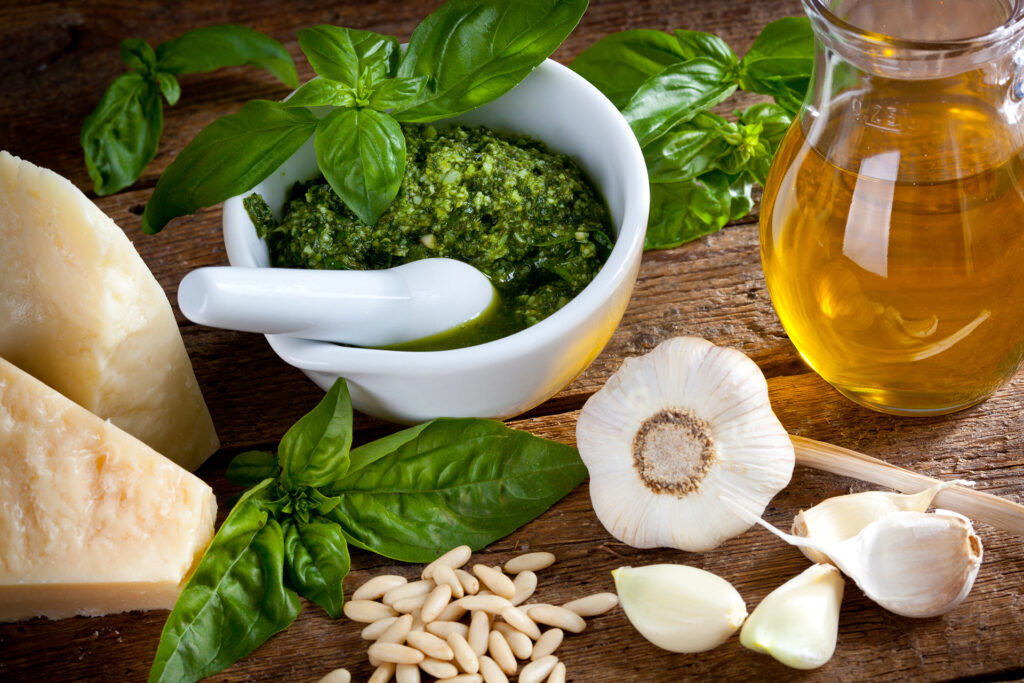A Taste Of Liguria. A Guide To Traditional Pesto
Ligurian Cuisine
Known for its coastal cuisine and fresh ingredients, Ligurian food is simple, traditional and delicious! The region’s most notable foods include Pesto, a sauce made with crushed basil; Focaccia, a flat leavened bread; Farinata, a thin pancake made from chickpea flour; Trofie, a short, thin twisted pasta made by hand and Pansoti, a vegetable and cheese stuffed ravioli served with walnut sauce, not to mention the seafood and fresh seasonal vegetables!

Hey Pesto
You are probably familiar with Pesto, a staple of Ligurian cuisine, not only for its bright green colour but also for its marvellous, almost indescribable taste. A flavour bomb of nutty, savoury, salty and fruity flavours. Pesto originates from Genoa, the capital of Liguria. The sauce has a long history deeply rooted in the local culinary traditions. In fact, the bright green colour of this most famous Ligurian dish inspired the colour “Margarita Green” in our latest collection, LIGURIA.

A Small Kitchen In Genoa
Erica Monzani is a culinary researcher and food experience creator in Liguria. Her passion for food from the Ligurian region overflows from the pages of her website and blog, ‘A Small Kitchen In Genoa.’ Enrica organises cooking classes and experiences on Italian Riviera cuisine to share her passion, stories and knowledge. She believes “genuine homemade food is a magical tool that pulls people together, to create a sense of community and family.”

A Few Rules
Pesto, a thick, green, uncooked sauce, is a firm staple of Ligurian cuisine, made using only a few simple ingredients like fresh basil, garlic, pine nuts, parmesan cheese, and olive oil. But take heed, to create genuinely authentic Pesto, you must know the traditions and some rules to abide by before you begin! If you want to make a delicious, original Pesto, read Enrica’s recipe ‘The Complete Guide To Genoa Pesto Sauce’, which includes all the necessary information, including the correct ingredients, tools and the secret tips and tricks of Genoese cooks.

The Ingredients
Use the freshest ‘Genoese basil’ for the best flavour and the smallest leaves for a gentler taste. The quality of the basil is crucial to the Pesto’s final flavour. Additionally, new-season Garlic is best used and imparts a more delicate flavour. If the garlic is old, use less and remove the inner green piece, which can taste strong. To make authentic Genoese Pesto, use Pine nuts which should traditionally come from Tuscany. Although you may find these hard to purchase where you live so, buy what’s available locally. Alternatively, you could use Walnuts, a popular feature in Ligurian Cuisine. Purists always use Parmesan cheese but feel free to mix in Pecorino for more of a spicy, salty taste.
Extra virgin Olive Oil is essential. The oil plays an important role, amalgamating the flavours and locking in the essential oils from the basil. In fact, Olive oil is another secret to keeping that bright green colour because it prevents the basil from oxidising.
Kitchen Notes
Italian cooks make Pesto by hand using a marble Mortar and Pestle to give the best flavour and texture. Traditional Mortars are carved from marble from Carrara in Tuscany and have been used for centuries in Italian kitchens. Pestles, used to grind the ingredients to a paste, are made with softwood. The cold marble prevents oxidation of the basil and maintains its bright green colour. Italian cooks, including Enrica, use a food processor when short on time and so can you. Don’t worry. We won’t tell if you don’t!
To wash or not to wash! Some traditionalists do not rinse the basil leaves as it removes some essential oil however we always recommend washing to be safe. using a salad spinner will ensure the leaves are dry. Any leftover water will make the sauce watery.
Recipe
- 1 or 2 garlic cloves.
- 1 scooped tablespoon of pine nuts
- 1 Large bunch of fresh basil, leaves only, approx 60 leaves
- pinch of coarse salt
- 1 ½ tablespoons of freshly grated parmesan cheese.
- ½ tablespoons grated pecorino cheese.
- 4 tablespoons of Extra Virgin Olive Oil
Method
- Wash and dry basil leaves and remove the stem.
- Crush garlic and 1/3 of the pine nuts in a mortar to a cream.
- Add the remaining pine nuts, 2/3 of the basil leaves, and a pinch of salt to the mortar. Grind the mixture to an even paste.
- Add the remaining basil leaves and cheese to the mortar and grind, tasting to check the seasoning.
- Add the oil, stirring gently. N.b. keep the pesto under a light layer of oil to prevent oxidation.
- Enjoy!
Traditions in Pesto making are passed down through the generations and are essential to this region’s culinary heritage. The versatile sauce makes a delicious topping for grilled meats and vegetables or as a spread on bread. Serve pesto traditionally with Trofie pasta. This dish is a most beloved and essential part of Ligurian cuisine.
Want to know more about Ligurian regional cuisine? Check out Enrica’s website. Browse the online and in-person courses and Ligurian food experiences on offer! Take part in a food tour of the area or book one of Enrica’s traditional Pesto making classes.



